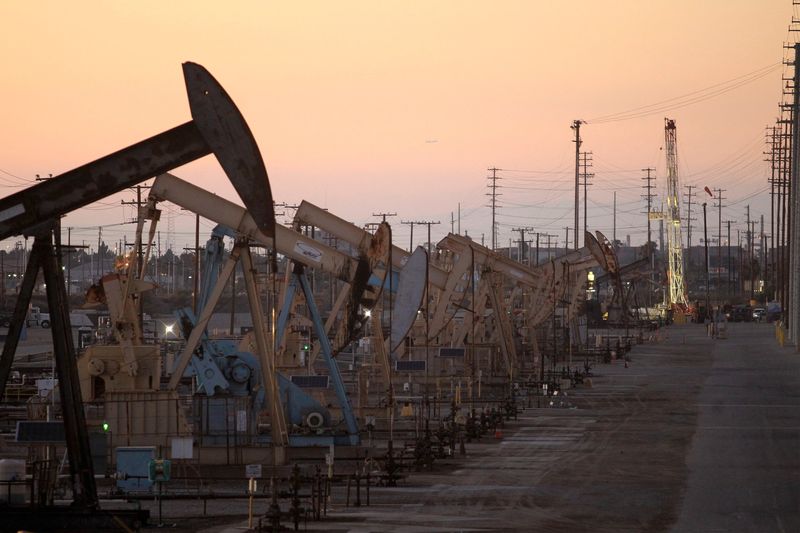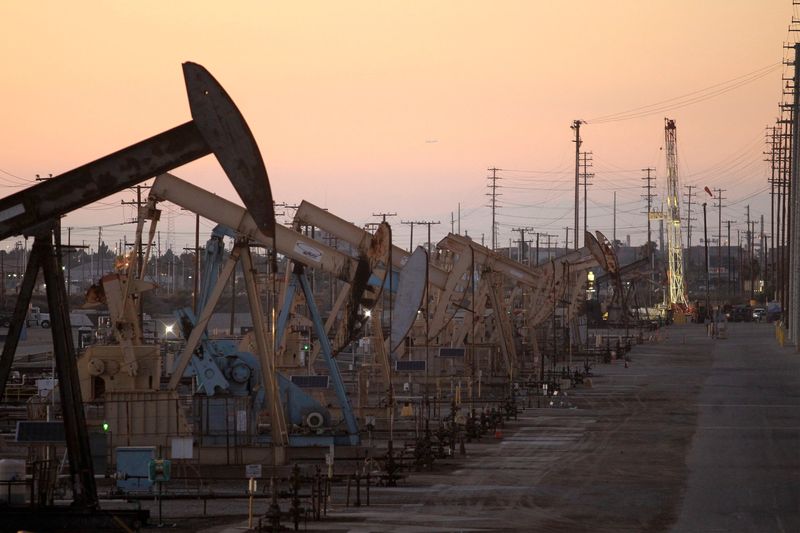Commodities
Oil gains as Gaza ceasefire talks in focus


© Reuters. FILE PHOTO: Oil rig pumpjacks, also known as thirsty birds, extract crude from the Wilmington Field oil deposits area near Long Beach, California July 30, 2013. REUTERS/David McNew/File Photo
By Paul Carsten
LONDON (Reuters) -Oil prices maintained upward momentum on Tuesday as investors awaited the result of top U.S. diplomat Antony Blinken’s efforts in the Middle East to halt the Gaza war and quell tensions in a major oil-producing region.
futures gained 55 cents to $78.54 a barrel by 1224 GMT, while U.S. West Texas Intermediate crude futures rose 48 cents to $73.26. Both contracts gained nearly 1% on Monday, rising for the first time in four sessions.
“The signs of de-escalation in the Middle-Eastern crisis are missing and continue to extend some support to ailing oil prices,” said Phillip Nova senior market analyst Priyanka Sachdeva.
As part of his trip to the region, Blinken met Saudi Arabia’s de-facto ruler on Monday, and on Tuesday landed in Cairo for his meeting with Egyptian President Abdel Fatah al-Sisi. Palestinians hope the visit will clinch a truce before a threatened Israeli assault on Rafah, a border city where about half the Gaza Strip population is sheltering.
The ceasefire offer, delivered to Hamas last week by Qatari and Egyptian mediators, awaits a reply from militants who say they want more guarantees it will end the four-month-old war.
At the same time, the United States continued its campaign against Iran-backed Houthis in Yemen, whose attacks on shipping vessels have disrupted global oil trading routes. The group has described their recent attacks as acts of solidarity with Palestinians.
The U.S. strikes “do not point to an easing of tensions”, said Commerzbank (ETR:) analysts Thu Lan Nguyen and Carsten Fritsch in a note.
Yet souring demand expectations limited oil’s gains.
Analysts said expectations of “higher for longer” interest rates in the U.S. and elsewhere plus China’s shaky economy could cap consumption.
CMC Markets (LON:) analyst Leon Li also said it would be “difficult to return to previous highs” given that the run of strong economic indicators from the U.S. would likely lose steam.
“Layoffs are still increasing. This means that in the long term, the (oil) demand will decline,” Li said.
On the supply side, market participants are awaiting industry data due later on Tuesday on stockpiles. Five analysts polled by Reuters estimated on average that crude inventories rose by about 2.1 million barrels in the week to Feb. 2.
Commodities
Oil prices rise; U.S. crude inventories plunge, Russia-Ukraine truce eyed
Commodities
India’s Reliance to stop buying Venezuelan oil over US tariffs, sources say
Commodities
Oil prices climb on Venezuela supply worries

 Forex3 years ago
Forex3 years agoForex Today: the dollar is gaining strength amid gloomy sentiment at the start of the Fed’s week

 Forex3 years ago
Forex3 years agoUnbiased review of Pocket Option broker

 Forex3 years ago
Forex3 years agoDollar to pound sterling exchange rate today: Pound plummeted to its lowest since 1985

 Forex3 years ago
Forex3 years agoHow is the Australian dollar doing today?

 Cryptocurrency3 years ago
Cryptocurrency3 years agoWhat happened in the crypto market – current events today

 World3 years ago
World3 years agoWhy are modern video games an art form?

 Commodities3 years ago
Commodities3 years agoCopper continues to fall in price on expectations of lower demand in China

 Economy3 years ago
Economy3 years agoCrude oil tankers double in price due to EU anti-Russian sanctions























